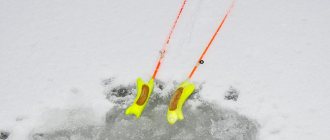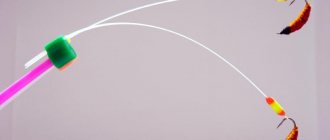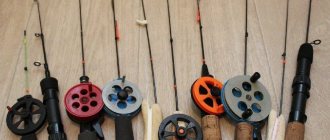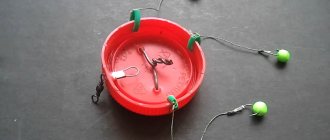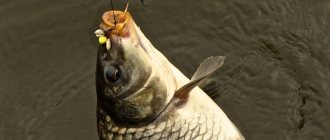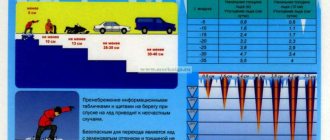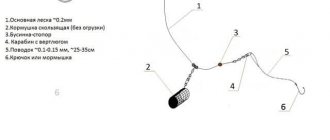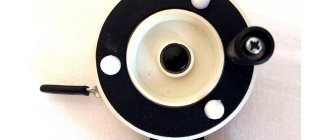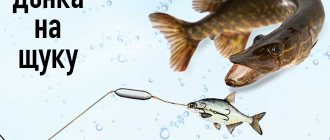Reeds, cattails and any other aquatic vegetation – favorite habitat of crucian carp. He happily eats young shoots of plants, small crustaceans and larvae that live directly in the root part and upper layers of silt.
This fish not only feeds here, but also hides from predators and also spawns. It is among the aquatic thickets that crucian carp spend most of their lives. This means that in such places the probability of catching the desired trophy is highest .
Time to catch crucian carp in the reeds
Without knowing the reservoir, we can say with complete confidence that near thickets of reeds, cattails or water lilies it will not be difficult to find schools of crucian carp . Large individuals living alone are often found there. In terms of the time of year, crucian carp are happy to visit such places from mid-spring to the last warm days of autumn . Only with the onset of the first frosts do carp fish go deeper into wintering pits .
Regarding the time of day, everything is even simpler. The closer to the summer heat , the time of active biting shifts closer to sunrise and sunset, making the lunchtime bite practically zero. But in early spring and late autumn , in the absence of serious frosts, the time of active search for food for crucian carp begins only from the moment when the water begins to warm up in the sun’s rays. The depth at such moments can be minimal . You will certainly notice this by the characteristic movement of the shoots peeking out of the water.
Float rod
No bait. Fishing for crucian carp with a float without using bait. Find out what kind of tackle and equipment you need to catch fish that require active feeding by watching this video.
How to catch fish with 2 hooks at once. Video about calm fishing for crucian carp with not exactly sporting tackle. Let me remind you that fishing with two hooks is prohibited by Russian law.
Fishing for crucian carp with a side nod and jig. How to catch crucian carp using a light fly rod with a side nod, how to feed the fish and build the process of waiting for a bite.
Fishing with garlic. What attractants help catch crucian carp, how to take into account the weather and choosing the right place for fishing - you will learn about all this in the following video.
Float rod from a boat in the reeds. The author of the video talks about how to choose a place for fishing for crucian carp, how to prepare bait and properly feed white fish in places with dense vegetation. What his tackle looks like, about baits and attachments and fishing techniques - see in more detail.
Large crucian carp. How do you catch large crucian carp, how does the bite pattern of large crucian carp differ from small ones, what are the peculiarities of choosing future fishing, and is a boat really needed in search of a trophy specimen?
Float equipment. In this video you will not hear the voice of the author, but it shows a detailed explanation of the complete assembly of various types of float rigs, suitable for fishing in currents and in still water, at great depths and in shallows, for small and large crucian carp. Also, don’t miss the opportunity to look at a detailed explanation of the different types of crucian carp bites and exactly how to recognize them.
Crucian carp in early spring. At what point can you start catching crucian carp in the spring? How to choose tackle and equipment, what to bite on and what to feed.
In the heat of summer. What to do if the weather is very warm even on the pond? White fish bite only in the early morning hours and late in the evening. The video describes and shows the nuances of catching crucian carp in hot summer weather.
Autumn crucian carp. Despite the fact that this fish is one of the first to stop biting in the fall, it can still be actively caught by properly organizing the process of feeding, selecting baits and attachments. In 15 minutes, the author of the video will talk about the intricacies of catching crucian carp in the fall from a boat, although this knowledge can also be applied when fishing from the shore.
Finding a location and preparing it
A catching place can be either a small window in dense vegetation, or simply a strip along the border of clear water and the beginning of reeds or cattails. The fish feels more confident just in the windows , due to the lack of open water space. The depth can vary from 15-20 centimeters to one and a half to two meters .
If you haven’t found such places on the pond, then you can completely clear a small window of a couple of square meters yourself.
When fishing from a boat, you don't need anything other than gear and cleared space. But for shore casting, it will be necessary to clear a kind of “clearing” so that the tackle does not cling to vegetation.
Important! Although crucian carp is a shy fish, after you have set up your fishing spot, you can safely feed it and start fishing. The waiting time will not be that long. Only in extremely unfavorable cases may the cleaned area need to rest for a couple of days.
Float rod
No bait. Fishing for crucian carp with a float without using bait. Find out what kind of tackle and equipment you need to catch fish that require active feeding by watching this video.
How to catch fish with 2 hooks at once. Video about calm fishing for crucian carp with not exactly sporting tackle. Let me remind you that fishing with two hooks is prohibited by Russian law.
Fishing for crucian carp with a side nod and jig. How to catch crucian carp using a light fly rod with a side nod, how to feed the fish and build the process of waiting for a bite.
Fishing with garlic. What attractants help catch crucian carp, how to take into account the weather and choosing the right place for fishing - you will learn about all this in the following video.
Float rod from a boat in the reeds. The author of the video talks about how to choose a place for fishing for crucian carp, how to prepare bait and properly feed white fish in places with dense vegetation. What his tackle looks like, about baits and attachments and fishing techniques - see in more detail.
Large crucian carp. How do you catch large crucian carp, how does the bite pattern of large crucian carp differ from small ones, what are the peculiarities of choosing future fishing, and is a boat really needed in search of a trophy specimen?
Float equipment. In this video you will not hear the voice of the author, but it shows a detailed explanation of the complete assembly of various types of float rigs, suitable for fishing in currents and in still water, at great depths and in shallows, for small and large crucian carp. Also, don’t miss the opportunity to look at a detailed explanation of the different types of crucian carp bites and exactly how to recognize them.
Crucian carp in early spring. At what point can you start catching crucian carp in the spring? How to choose tackle and equipment, what to bite on and what to feed.
In the heat of summer. What to do if the weather is very warm even on the pond? White fish bite only in the early morning hours and late in the evening. The video describes and shows the nuances of catching crucian carp in hot summer weather.
Autumn crucian carp. Despite the fact that this fish is one of the first to stop biting in the fall, it can still be actively caught by properly organizing the process of feeding, selecting baits and attachments. In 15 minutes, the author of the video will talk about the intricacies of catching crucian carp in the fall from a boat, although this knowledge can also be applied when fishing from the shore.
Tackle
To catch crucian carp in the grass, Bolognese, telescopic and fly rods . The telescopic fishing rod is compact and easy to transport. And this is its main advantage. Still, ideally, when fishing for crucian carp, it is better to take fly rods with minimal weight. Determine the length yourself. The dependence is simple and obvious: the farther from the shore the casting point, the longer the rod .
When assembled, a fishing rod for crucian carp for fishing among vegetation is simple and light. It is better to avoid reels and guides in favor of tying the line to the rod tip. The float should be selected as sensitive as possible with light weight, and one pellet is enough for loading. The neater and simpler the tackle , the higher the chance of catching a trophy crucian carp. After all, you need an instant reaction . Otherwise, the fish will go into the reeds and this will lead to breakage of the gear.
The thickness of the line depends on the expected weight of your trophies, but, as a rule, the cross-section should not exceed 0.2 millimeters in diameter for the main line and 0.15 millimeters for the leader. The rule is clear: the thinner the better . Use a landing net if you are not sure of successfully landing fish. The length of the leash depends on the fishing depth. If we take averages, they should be within 10-20 centimeters. A longer leash will give the crucian carp freedom and it will be much easier to get tangled in underwater vegetation. The choice of hook directly depends on the size of the crucian carp in the pond.
Attention! Choose a fishing line that matches the color of the water and bottom soil. Crucian carp is careful and attentive.
Fishing for crucian carp: tackle, baits, bait
Crucian carp is one of the most common and unpretentious fish in our reservoirs. This hardy fish is found everywhere. Another feature of crucian carp is that it is very tenacious and can withstand rather dirty and oxygen-poor water.
It would seem that crucian carp is one of the most typical and ordinary objects for fishing, and in every market there is an abundance of this fish.
However, catching large crucian carp can be a great pleasure; properly prepared fresh, non-market crucian carp can be very tasty, and the wide distribution of this species makes it possible to catch it in many reservoirs, even within urban areas.
Often you don't need to spend a lot of money on gas or tickets to catch crucian carp - they can live within half an hour's drive from your home. On the other hand, crucian carp can sometimes be very finicky, and catching it can be no easier than bream or other cautious fish. Then fishing turns into a test of the fisherman's skill and becomes an interesting adventure.
Where to catch crucian carp?
Crucian carp is very common. Its range is a significant part of Eurasia - from the Iberian Peninsula to the Urals. If we look at specific bodies of water, then specimens of decent weight are found in large rivers.
Large crucian carp live in sufficient quantities in lakes and coastal estuaries, sometimes entering brackish water and reservoirs. The leaders in size - crucian carp, caught in the east of their range - in the lakes of the Urals, reached 4-5 kg in weight.
If we take specific conditions, then crucian carp is very unpretentious to the quality of water - it is not pike perch or burbot. It lives in rivers, lakes, reservoirs, stakes and ponds, in canals, in deep swamps and mined-out quarries.
It is one of the few fish that lives in completely stagnant, stagnant or freezing bodies of water. In the latter, crucian carp burrow deep into the mud in winter and survive this way. Fish also live within the city - in ponds, small rivers and cooling ponds of power plants.
Crucian carp does not like strong currents, preferring weak or no water flow at all.
Consequently, in lakes, stakes and ponds it is found everywhere (except perhaps in “favorite” places), and on rivers and reservoirs it prefers areas where the flow slows down - backwaters, bays.
There he has “feeding routes” - if you find them, then the catch is guaranteed. Crucian carp loves aquatic vegetation - many anglers have noticed how the reeds move from the movement of fish below - this is crucian carp looking for food at the roots.
So, catching crucian carp with a float rod in reeds, cattails and other plants is much higher than on an empty bank. Of course, crucian carp also love deep places in the center of the reservoir, but near the wall of reeds you can always stumble upon a representative of their tribe.
Despite the low oxygen consumption, crucian carp does not like places that are too shallow - they usually bite from the bottom if the depth exceeds 50 cm, and even more often - at least 70-100 cm. Again, the presence of thickets of aquatic vegetation encourages crucian carp to approach closer to the shore – after all, you can find a lot of tasty things there.
As already mentioned, large crucian carp live in large bodies of water, where there is a predator that eats part of the small fish, and the surviving fish grow to a decent size. And in isolated reservoirs, where there are no predatory fish, there is a lot of crucian carp, but it is small - 50-100 grams. weight.
Interesting fact! Considered harmful, the sleeper sleeper (it eats the eggs of other fish), which ends up in such rates, has a beneficial effect on the size of the crucian carp - it eats the juveniles, allowing the rest of the fish to eat better and grow larger. And the rotan itself is larger there - due to the fish diet.
Nozzles for crucian carp
On the one hand, crucian carp is quite omnivorous, on the other hand, it can be picky, especially in the summer, when there is a lot of food. A characteristic feature is that in spring and autumn, when underwater vegetation is sparse, crucian carp are more willing to bite on animal baits, and in the summer – on plant baits. But this does not mean that in the summer crucian carp will not take worms.
The main rule is to have several different attachments on hand, which will contribute to success.
- Animal baits: Worms. The most classic ones, indicated by Sabaneev in the 19th century. Especially dung ones - tenacious, active on the hook, with an attractive smell. You can put the worms overnight in a container with aromatic substances (oils, herbs) - there they will acquire a special aroma.
- Maggot. Several pieces are placed on the hook. Sometimes more catchy than a worm.
- Caddisfly. You can also use it for experience.
- Bloodworm. Suitable for catching crucian carp in winter.
- Bread. Gray and black, less often white. It is not bad in many cases, the most affordable attachment.
By the way, about aromas - crucian carp loves appetizing smells, take advantage of it. Flavors for crucian carp fishing can be either natural or artificial.
You can add drops of unrefined sunflower oil, flavorings such as anise, garlic, caramel, and honey.
Regular sugar or vanilla will also work. Remember - do not overdo it with smells, otherwise you will scare away the fish, especially if you go fishing to catch not only crucian carp, but also carp.
Important! Mix plant baits with water from the reservoir where you will fish.
Bait for catching crucian carp
The bait can be used during fishing, as well as as bait; first feed the intended area a day or two in advance for successful fishing.
- Privada. This is food that is poured into the water in advance in order to attract fish to a specific place. Usually it is left for several weeks so that the fish remember the feeding place. If you go to a permanent fishing spot - to a dacha, a village, etc. - add fish every week - this will give a good result. For bait, simple bait will do - sunflower cake (makukha), crackers, etc. Do not overfeed the fish!
- Lure. Bait is thrown immediately before and during fishing so that the fish pays attention to the right place. Use regular bait or special bait from the store (consult the seller). You can make the mixture yourself - combining cakes, cereals, crackers, and oils for flavor.
The main condition is that the bait for catching crucian carp should attract the fish with its smell, and not saturate it - it should disintegrate easily and not form large lumps. The bait on the hook should be more nutritious than groundbait. It is better to use “fried” flour, exceptionally fresh, with a pleasant, non-rancid odor.
Tackle for crucian carp fishing
Crucian carp uses both float and bottom tackle. In this regard, crucian carp fishing is varied - you can put a donk and a float rod next to each other and remove crucian carp from both.
Tackle for catching crucian carp with a float rod requires a rod 4-5 m long, light and durable. It can be with blind equipment or with a reel. A medium-sized hook for catching crucian carp, with a short shank - crucian carp is not a perch, it does not swallow hooks. It is convenient to place a ball of semolina or a small worm on a short hook so as to completely cover it.
Which float is best for catching crucian carp? A float is a feather or an artificial one similar in shape. You can use a float for long casting - a “wagler” type float with sliding equipment. Basically, crucian carp are caught from the bottom - so that the float lies at an angle to the water. Or near the bottom - crucian carp mainly feeds in the bottom layers of water, although it can also eat duckweed on the surface (but then it is difficult to catch).
It is advisable to use a leash made of a thinner fishing line that matches the color of the water, so as not to scare away the more cautious large crucian carp (diameter 0.15-0.18 mm, unless large fish such as carp or bream are expected).
A crucian bite looks like this - usually the float lies on the water and trembles. You need to hook at the moment of lowering or immediately after it lies down. If it’s later, the crucian carp will spit it out or knock down the bait. Sometimes the float bounces and floats to the side. Less often, crucian carp drowns it, like perch.
Long casting tackle
Crucian carp are also willing to use bottom gear - feeder, picker, rubber donk. The difference is that you won’t be able to use dough, semolina and bread - when you throw or release the rubber band, they will simply be washed away with water. The main baits are worm, maggot, pearl barley. Use a feeder with slowly eroding groundbait - factory-made or homemade.
Crucian carp can also bite on technoplankton - a Hungarian tackle for catching silver carp and grass carp. Moreover, it falls on fairly large hooks designed for large fish, or it clings to its belly, trying to try the pill.
Features of crucian carp fishing
Some secrets of catching crucian carp:
- It bites best at dawn, a little worse in the evening (after 16 hours), during the day it bites mainly in spring or autumn, when it is fattening. In summer it bites mainly at 5-10 o'clock in the morning;
- crucian carp loves vegetation - reeds, etc. Try looking for it there;
- Contrary to popular belief, it bites even in winter, but sluggishly. In winter, crucian carp should be looked for in pits or near warm places - spillways, etc. It is not completely caught only where the water freezes - there it buries itself in the silt;
- You can also fish from a boat - for example, find a feeding route for crucian carp at a reservoir. Fishing along the line of reeds or islands of vegetation also works well;
- if it is possible to make a permanent place - a bridge, a masonry, cut a window in the reeds from the shore to the open water - great, the prized crucian carp will bite there perfectly. The main thing is to plant regularly and not litter these places;
- large crucian carp is very careful - although it is not a bream with its famous suspiciousness, but if you are fishing with a float, you should not make noise, move sharply, etc. Also, a broken large crucian carp worsens the bite of the entire fish for a long time;
- feel free to use flavors – both natural and store-bought, but don’t get carried away.
The best tackle for a spinner!
spincatana.ru Catana Shimano rod + reel. An excellent set: spinning rod + reel kastcking.ru Such tackle will definitely not let you down when fishing... Now you won’t have to return from fishing empty-handed! aktivlov.ru If you just add this component to the bait... narybalke
vsegdanarybalke.ru
Nozzles
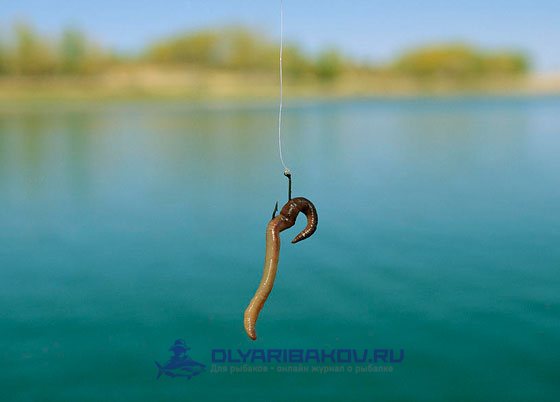
- worms (dung and earthworms);
- bloodworm (mosquito larva);
- maggot (fly larva).
The caddisfly and other inhabitants of the reservoir are less in demand.
As for vegetable attachments , there are much more variations here, starting with dough and bread, ending with all kinds of cereals. For plant baits, flavorings , both natural and artificial, often give a good effect. The most popular among crucian carp are:
- vanilla;
- anise;
- cinnamon;
- vegetable oil;
- garlic.
Important! It is important to use the amount of flavoring carefully, without exceeding the permissible limit. Otherwise, you will only scare away the fish.
Lure
Bait plays a key role in fishing success. With its help, you not only attract the attention of underwater inhabitants, but also firmly keep them in the zone you need. ready-made dry mixtures on sale , which are recommended for a specific type of fish or can be universal. You can trust the professionals and not tempt fate. However, preparing bait exclusively from packaging will cost you a lot and in any case, the so-called “base” will be needed in the final bait . Its function will be perfectly fulfilled by sunflower cake (cake), or any porridge.
Many experienced crucian fishermen strongly recommend adding a little soil directly from the reservoir where you plan to fish to the final bait mixture. This way the finished mass itself will taste more familiar to the fish and will not be eaten so quickly.
Important! Feeding constantly and a lot does not make any sense. It is enough to provide high-quality bait only before starting fishing. And then, only periodically feed it so that the fish does not leave the place where you are fishing. Otherwise, the crucian carp will simply eat up, and your bait will cease to be of interest to him at all. It is better to choose a place for casting bait that is equidistant from vegetation, in an open area of water, but in close proximity to the reeds. This way the crucian carp will feel more confident and this will subsequently have a qualitative impact on the bites.
More information about bait for crucian carp
Fishing from a boat
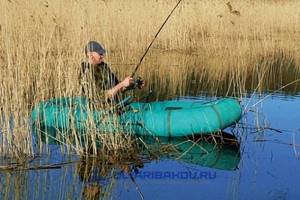
Some useful tips
Finally, it would not be superfluous to clarify the important nuances of catching crucian carp in the reeds. The best casting location will always be a point in close proximity to vegetation , literally under the reeds.
The higher the air temperature, the more actively the crucian carp reacts to baits of plant origin .
Try not to make unnecessary noise or make sudden movements. Crucian carp is very shy .
Combine and change baits if the presence of fish is obvious, but it does not want to peck at the baits you offer.
Bait for summer crucian carp
In reed thickets in early spring, in the morning hours, it bites very weakly, and this is explained by the fact that in the morning the water is still slightly warmed up. During the daytime, the bites begin to intensify.
Already somewhere in the middle of spring, when the water in the reservoir warms up quite well, crucian carp bite better in the mornings or in the evening. By the end of spring, during the daytime, there are practically no bites of crucian carp.
And here's what you need to know: Float tackle for crucian carp. Which float is better for crucian carp
Reed thickets in a reservoir are characterized by the fact that the depths here do not exceed more than two to three meters. But it is best to fish at a depth of one and a half meters, no more.
When catching crucian carp in the reeds of a pond, it is better to worry in advance and feed the crucian carp. In this case, it is better to start feeding approximately two or three days before fishing. It is in this way that crucian carp from all around the reservoir will be collected at this fishing location.
You should feed crucian carp with store-bought mixtures, or you can make the bait yourself. How to make bait for catching crucian carp in the summer? Yes, very simple! To prepare the bait, you can use macadamia as a base, as well as cookie scrap; it costs a penny on the market.
Crucian carp loves the smell of vanilla flour, which is used for making baked goods and other confectionery products. You can add an attractant (flavor) to the prepared mixture; it can be either a store-bought one with different shades of smell, or an ordinary natural one, for example, a little sunflower oil.
When adding an attractant, be guided by the time of year when you fish; for example, in winter it is better to avoid flavorings altogether and use finely chopped bloodworms in the bait. If you catch crucian carp in the summer, then bright smells are suitable - plum, anise, tutti - frutti.
Fishing for crucian carp in summer is basic for a novice angler; this fish is not as picky as other inhabitants of the reservoir, but still requires a responsible approach.
